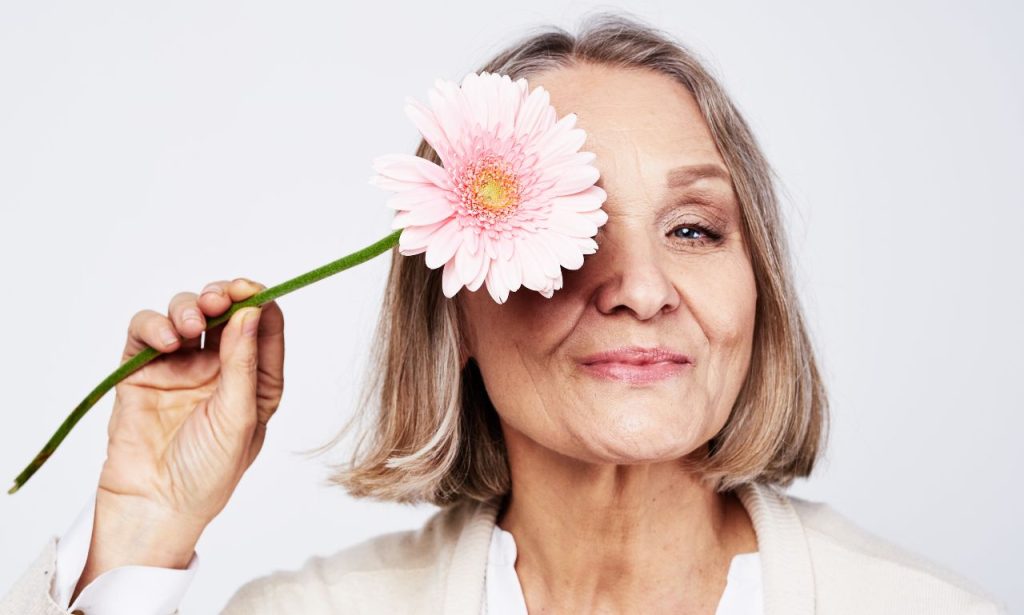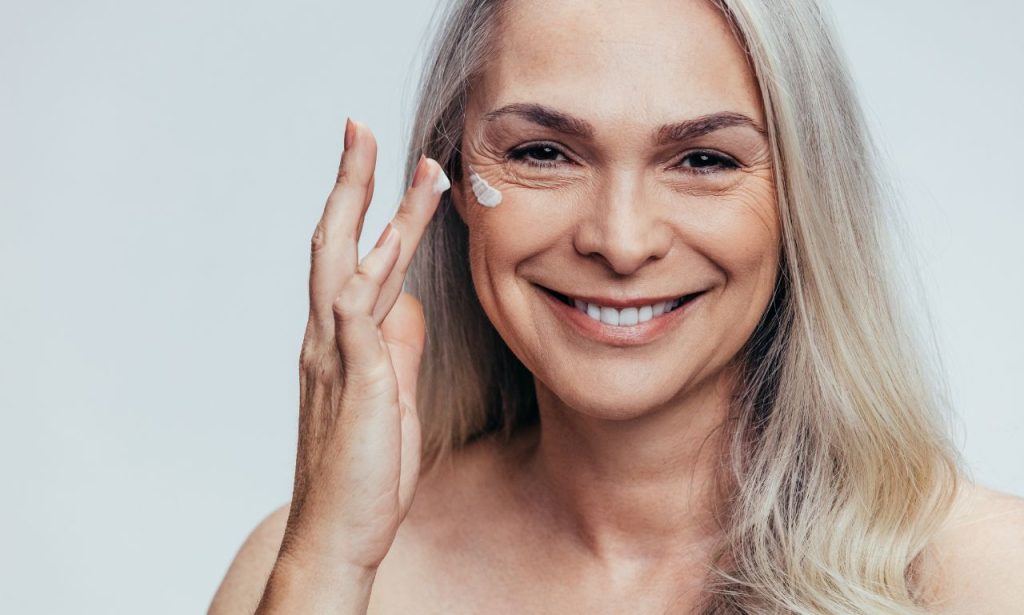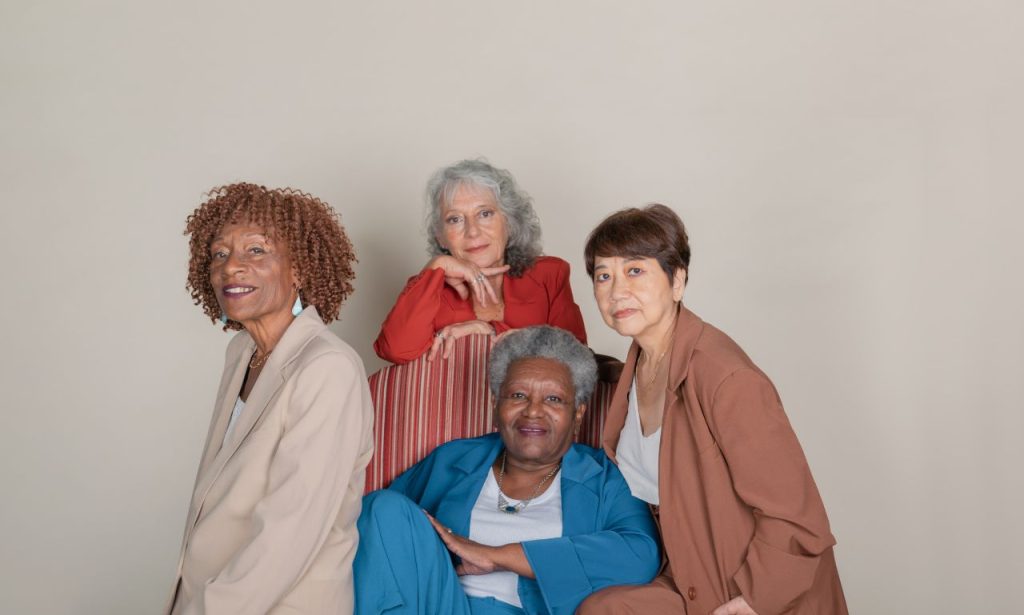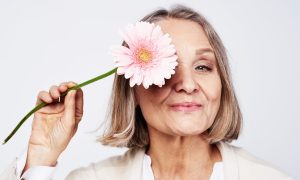Aging is inevitable, but doing it with grace and style is a choice we can all make. The journey through our later years doesn’t have to be marked by resignation—instead, it can be one of our lives’ most liberating and expressive chapters.
I’ve always believed that aging isn’t about fighting time but embracing the wisdom and confidence that comes with it. The beauty of growing older lies in knowing yourself better than ever and having the courage to express that knowledge through your style.
Refeather Your Nest
The older you get, the more important it is to build a house that reflects who you’re becoming, not who you used to be. Your home needs to be a haven and a representation of who you’re becoming.
I completely revamped my home office last spring. Decades of dark wood and stodgy decor finally got the boot when I painted the walls a bright teal blue and purchased a mid-century modern desk. The energy shift was immediate—my creativity erupted in this new environment that better suited who I am now, not who I was twenty years prior.
Your surroundings deeply impact your mindset. Consider colors that energize you, furniture that supports your body comfortably, and objects that tell your evolving story. Decluttering isn’t just trendy advice—it’s about making space for new experiences and shedding what no longer serves your current chapter.
Don’t be afraid to mix cherished antiques with new furniture. These contrasts create dynamic spaces that honor your history without confining you in it. Make sure to let your home evolve with you instead of trapping you in it.
Get a Culture Fix

Cultural engagement keeps us connected to the world around us and helps us maintain perspective as we age. Museums, concerts, theater, and even street art can spark joy and expand our worldview.
The arts have afforded a unique type of communion with humanity throughout the ages. Attending a symphony or walking through a gallery connects us to creative expression outside our life experience. This connection is important as we reconcile the sometimes-isolating facts of aging.
Try to expose yourself to art forms outside of your comfort zone on a regular basis. If you’ve always been a fan of classical music, go and see a jazz concert. If you adore paintings, check out sculpture or computerized art installations. These little excursions keep our minds supple and our spirits active.
Cultural activities also inherently provide opportunities for social connection. Consider book clubs or museum membership programs. Such groups form relationships around shared interests and create regular touchpoints of meaningful interaction.
Buy Yourself Flowers
Small luxuries make a significant difference in how we experience daily life. Treating yourself to fresh flowers, quality chocolate, or a beautiful notebook isn’t frivolous—acknowledging your worthiness.
I’ve made it a weekly ritual to visit my local flower market on Saturday mornings. Selecting seasonal blooms and arranging them throughout my home brings a sensory richness to my environment that lifts my spirits immediately. This simple practice reminds me to appreciate beauty in all its ephemeral forms—much like the beauty of each phase of life.
These small indulgences create moments of pleasure that punctuate our days with gratitude. They remind us that joy isn’t reserved for special occasions but can be woven into the fabric of ordinary time. Aging gracefully includes giving yourself permission to experience these pleasures without guilt.
Consider what small luxury might brighten your everyday experience. It might be premium tea served in a special cup, a subscription to handcrafted stationery, or a quarterly massage. These aren’t extravagances—they’re investments in your quality of life.
Stimulate Your Senses

Our senses can dull with age if we don’t actively engage them. Deliberately seeking rich sensory experiences keeps us present and appreciative of the moment.
Experiment with new scents through essential oils or quality candles. Sound can transform our mood instantly—create playlists that energize, calm, or inspire you. Touch matters deeply—invest in fabrics that feel wonderful against your skin, from bedding to clothing.
Taste is perhaps our most accessible sensory pleasure. Trying new cuisines or revisiting childhood favorites with an adult palate can bring unexpected joy. Even familiar foods can become discoveries when approached with mindful attention.
Visual beauty is everywhere when we train ourselves to notice it. Take photographs of ordinary objects in extraordinary light. Visit gardens in different seasons. Watch how shadows play across your living room at various times of day.
Embracing Change
Resistance to change accelerates the aging process both mentally and physically. Flexibility—in our bodies and thinking—is a hallmark of youthful energy at any age.
Change is the only constant in life, yet many cling to outdated versions of ourselves. Releasing who you were to become yourself requires courage, but it’s essential for graceful aging.
Start with minor adaptations. Try a new hairstyle, rearrange your furniture, or take a different route to familiar destinations. These minor shifts prepare us for the more significant transitions that inevitably come with aging.
Practice updating your self-image regularly. The person you are at 60 isn’t who you were at 40, just as your 40-year-old self differed from your 20-year-old self. Acknowledge these evolutions with curiosity rather than resistance.
Staying Active and Strong
Physical vitality underpins everything else in our lives. Movement isn’t optional as we age—it’s essential for maintaining independence and energy.
Find activities that bring you pleasure rather than feeling like punishment. Dancing, swimming, walking with friends, or gentle yoga can all build strength and flexibility without strain. The best exercise is always the one you’ll do consistently.
Strength training becomes increasingly important as we age. Light resistance helps maintain bone density and muscle mass, which naturally decline over time. You don’t need a gym membership—simple hand weights or resistance bands at home can make a significant difference.
Balance exercises prevent falls and create confidence in your physical capabilities. Practice standing on one foot or try a tai chi class while brushing your teeth. These subtle movements have potent effects on your neuromuscular system.
Remember that rest is as important as activity. Quality sleep and proper recovery become more crucial with age. Listen to your body’s signals and honor its need for restoration.
Keeping Your Mind Sharp
Cognitive health requires regular exercise just like our bodies do. Learning new skills creates neural pathways that help maintain mental agility.
Challenge yourself to acquire knowledge in areas utterly unfamiliar to you. When I turned 50, I decided to learn the ukulele despite having no musical background. The frustration and eventual breakthroughs taught me more about persistence than any business venture ever had.
Read widely outside your usual interests. If you typically enjoy fiction, try a science journal. If history is your passion, explore poetry. These cross-disciplinary adventures keep your thinking flexible and introduce you to new perspectives.
Social engagement powerfully protects cognitive function. Regular conversations that require listening, responding, and considering different viewpoints exercise our brains in ways that solitary activities cannot replicate.
Digital literacy may not have been part of your early education, but it’s crucial for remaining engaged with contemporary life. Embrace new technologies with patience, knowing that each new skill you master strengthens your cognitive reserve.
Wear Whatever You Want
The greatest gift of aging is the freedom to dress authentically. The tyranny of trends fades as we recognize the power of personal expression through clothing.
Developing a signature style that reflects your personality becomes more important than following fashion dictates. This might mean embracing bold colors, interesting textures, or distinctive accessories that become associated with your presence.
Quality becomes more important than quantity. Invest in well-made pieces that fit your current body perfectly rather than holding onto clothes from previous decades. Having your favorite items tailored to your changing shape is an act of self-respect.
Comfort and style aren’t mutually exclusive. Today’s fashion offers elegant options in forgiving fabrics and cuts. Prioritize how clothing makes you feel—physically and emotionally—over arbitrary rules about “age-appropriate” dressing.
Choose Your Glam Level
Makeup and grooming routines should evolve as we age, but they needn’t disappear. Finding your comfort level with enhancement is deeply personal.
Some women embrace an utterly natural appearance as they age, while others enjoy the ritual and results of a complete makeup application. Either choice can be empowering when it’s truly yours.
If you wear makeup, techniques that worked in your younger years may need adjustment. Cream products often look more natural on mature skin than powders. Emphasizing your eyes or lips rather than attempting to “correct” natural changes can result in a fresher appearance.
Skincare becomes more important than coverage. Invest in quality moisturizers and serums appropriate for your skin’s current needs rather than trying to mask changes with heavy foundation.
What Not to Wear to Avoid Looking Older
While I firmly believe in dressing for yourself, confident choices can unintentionally add years to your appearance if that concerns you.
Clothes that don’t fit properly age anyone instantly. Too loose suggests hiding, while too tight creates unnecessary bulges. Proper fit is the foundation of elegant dressing at any age.
Outdated eyewear dramatically dates your appearance. Frames are an opportunity to showcase your personality while using current styles that complement your face shape.
Once considered slimming and sophisticated, all-black outfits can drain the color from mature complexions. Instead, try navy, deep greens, or burgundies that offer the same slimming effect while bringing warmth to your face.
Unintentionally worn-out items undermine an otherwise thoughtful outfit. Examine your clothes regularly for signs of fading, pilling, or stretched elastic, and retire pieces that have moved past their prime.
How Can I Look Attractive as I Age?
Attractiveness at any age stems primarily from confidence and authenticity. When you’re comfortable in your skin, that energy radiates outward.
Posture dramatically impacts how others perceive you. Standing and sitting with intention creates an impression of vitality and self-assurance. Consider yoga or Pilates to maintain the core strength that supports good alignment.
Your smile remains your most potent feature throughout life. Prioritize dental health, and don’t hesitate to show your genuine happiness. Nothing is more magnetic than joy.
Hair that suits your current face and lifestyle instantly refreshes your appearance. Be open to evolving your hairstyle rather than clinging to what worked decades ago. Many women find that softer cuts and strategic color choices enhance their natural beauty.
Expressive accessories draw attention to your style rather than physical changes. Statement jewelry, interesting scarves, or unique glasses become conversation-starters and expressions of your distinctive taste.
What Speeds Up Aging the Most?

While genetics play a role in how we age, lifestyle factors significantly impact how we look and feel as time passes.
Sun exposure without protection causes more premature aging than almost any other factor. Therefore, daily sunscreen application is non-negotiable if you want to maintain your skin’s elasticity and tone.
Chronic stress accelerates aging at the cellular level. Finding effective ways to manage life’s inevitable challenges through meditation, nature exposure, or creative outlets pays dividends in how you age.
Poor sleep quality undermines every aspect of health and appears quickly on our faces. Creating consistent sleep hygiene practices becomes increasingly important with each passing year.
Inflammatory diets heavy in processed foods, sugar, and alcohol visibly age us from the inside out. Nourishing your body with colorful produce, lean proteins, and healthy fats supports your body’s natural regenerative processes.
Isolation speeds cognitive decline and diminishes quality of life. Maintaining meaningful connections with others—whether family, friends, or community—provides essential support as you navigate aging.
Conclusion
Aging gracefully with style isn’t about denying the passage of time but embracing it with consciousness and intention. Each stage of life offers unique gifts and challenges. The later chapters can be among your most authentic and satisfying by remaining curious, adaptable, and true to yourself.
Style evolves throughout our lives, reflecting our internal growth and changing priorities. The ultimate sophistication is the confidence to express yourself genuinely—whether through your home, your wardrobe, or your daily choices—
Remember that aging is a privilege denied to many. Approaching this natural process with gratitude and creativity transforms it from something we endure to something we actively shape and celebrate.
ALSO READ: What are the Best Insurance Panels For Therapists?
FAQs
Not! Many people discover their most authentic style later in life, freed from workplace expectations and others’ opinions.
Only if you want to, makeup should always be a choice, not an obligation or a taboo. Adjust techniques as needed, but follow your preferences.
Begin by removing anything that doesn’t fit or make you feel fabulous. Then, identify colors and styles that energize you, regardless of age-appropriate dressing rules.
Daily movement—even a 20-minute walk—pays enormous dividends in maintaining mobility, mood, and cognitive function as one ages.
Contemporary haircuts and quality products for silver hair keep this natural transition looking modern and intentional rather than neglected.




